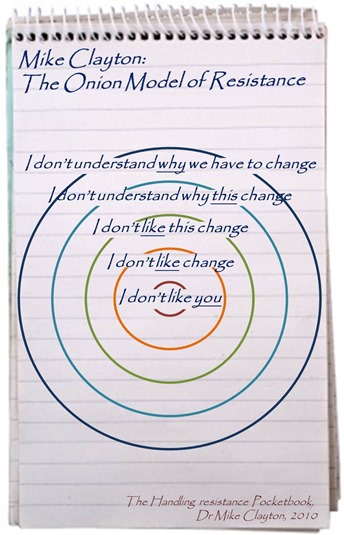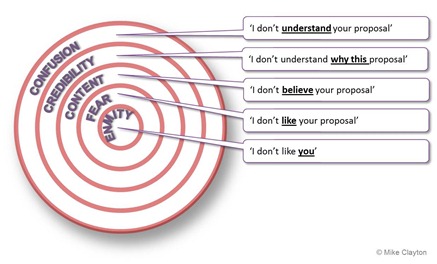Pocketblog has gone back to basics. This is part of an extended management course.
In the last couple of blogs, we have taken a look at how organisational change works in three phases, and how people respond to change. In this blog, we’ll focus on the ways in which people resist change and how you, as a manager, can deal with resistance.
Resistance is an inevitable part of people’s response to change and there are many reasons why people resist change. Dealing respectfully with that resistance requires that you can interpret the nature and reasons for the resistance, so the first skill to deploy will always be listening.
What you are listening for, will be clues as to what the source of the resistance is, so that you can address it properly. There are five levels of resistance, that lead to a simple, powerful model developed by Dr Mike Clayton (coincidentally, the author of this blog).
The Onion Model of Resistance
The Onion Model suggests five levels of resistance – each a little hotter and more emotionally charged than the last.
I don’t understand why we have to change
Resistance is often prompted by not recognising the need to change. People in organisations are usually only aware of pressures that impact upon them directly – leading them to say ‘we really must change this.’ But other pressures for change pass them by and it is therefore natural for them to question what they see as unnecessary change.
Address this form of resistance by showing why change is necessary
I don’t understand why this change
Even when people see the need for change, they also need to understand why you have chosen the response you have. You – or another manager – have gone through a series of investigations and decisions to choose your response but others have been outside of that process and naturally wonder if there is a better way.
Address this form of resistance by showing why your response is the most appropriate one.
I don’t like this change
At times of change, people often focus on what they will lose, giving it more weight than the corresponding gains. This hard-wired ‘loss aversion’ is a powerful driver of resistance even when objectively, the loss is small and the benefit is great. People will also resist when objectively the loss to them outweighs the benefit, but here, there is nothing you can do aside from acknowledging, sympathising, and supporting your colleague.
Address perceived disadvantage by patiently demonstrating the benefit.
Another reason for this form of resistance is that people sometimes spot a flaw in your plan. They may be wrong or right, but you must listen and evaluate carefully, and be prepared to make changes if you conclude that your changes are not the best you can make them.
I don’t like change
Change is a part of life that we all live with, but some have a greater tolerance than others. Those who feel they don’t like change are again focusing on what they fear losing, or simply on the fear that they will not be able to cope.
Address this form of resistance by offering support to help people overcome their fears and thrive in the new environment.
I don’t like you
This is rarely as personal as it sounds. In times of change, people lash out at whoever they can, as a way of exercising old frustrations and grievances, because the stresses of change add to the pressures they are under.
Accept a small amount of this only and address this as the inappropriate behaviour that it is. Use assertive behaviour and your other skills for dealing with difficult behaviour to deal with it in the first instance. If, on occasion, this is not enough, use your organisation’s formal procedures.

Other Pocketblogs you might find helpful






